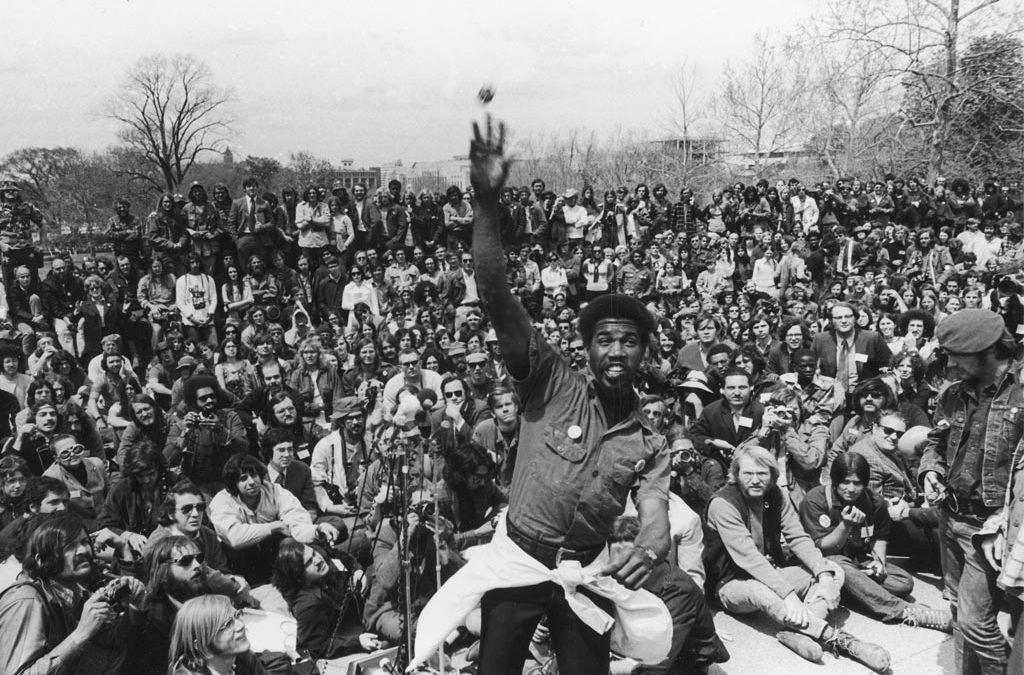In April 1971, more than a thousand Vietnam veterans descended on Washington, DC, for a series of antiwar actions dubbed Dewey Canyon III, “a limited incursion into the land of Congress.” For a week the veterans demonstrated and lobbied government officials to end the war, culminating in a dramatic ceremony at the steps of the Capitol on April 23 in which hundreds of veterans threw back their war medals.
Few Americans realized then or remember now that the pervasive antiwar movement that convulsed American society 50 years ago also pulsed through the armed forces. As an enlisted soldier during the war, I was one of the GIs who spoke out for peace. I have written widely on the subject. Here I focus on the impacts of the resistance and how it hastened the end of the war.
Individual and small group acts of dissent in the military began as early as 1965, and larger group protests appeared in the Army and Marine Corps in 1968 and spread to the Navy and Air Force. Peace demonstrations of more than a thousand soldiers took place near Fort Hood, Camp Pendleton and other U.S. bases, in the streets of San Francisco and other cities, and in Germany. More than three hundred antiwar newspapers were published by and for active duty service members, appearing at nearly every major military base and on many ships. One of the most visible statements against the war appeared as a full-page ad in the New York Times in November 1969 signed by 1,365 active duty service members. I was one of them.
By 1971 desertion rates in the military reached record levels. One out of every six soldiers went absent without leave that year. This deprived the military of approximately one million person-years of service, according to analysts Lawrence Baskir and William Strauss, and had “an enormous impact on the ability of the armed forces to function.” A 1971 article in Armed Forces Journal reported that morale, discipline and battle worthiness were “lower and worse than at any time in this century and possibly in the history of the United States.”
The impact of resistance in the ranks was magnified in the crucible of Vietnam and began to diminish military effectiveness. In October 1970, Life Magazine published an article about a combat unit with the title: “You Can’t Just Hand Out Orders.” It portrayed a young company commander on patrol agreeing with his troops to avoid combat. The article described an implicit understanding between the commander and his men to avoid contact with enemy forces. Such arrangements became increasingly prevalent in the latter years of the war. “Working it out,” it was called. The generals issued orders for “search and destroy” missions, but the troops on the ground often followed a practice of “search and evade.” Few soldiers wanted to risk their lives in what they saw as a hopeless cause.
Many acts of direct combat refusal also occurred. I documented ten known incidents in my book, Soldiers in Revolt. Former combat commander Shelby Stanton later wrote in The Rise and Fall of an American Army that thirty-five incidents of combat refusal were recorded in the 1st Cavalry Division in 1970. If we extrapolate that experience to the other six Army divisions and one Marine division in Vietnam that year, the total number of likely mutinous events was probably in the hundreds.
Secretary of Defense Melvin Laird and other senior officials were shocked by the extent of disintegration within the ranks and argued for faster troop reductions. Laird recognized, his biographer wrote, that the war was “destroying” the military. Faced with the pervasive internal crisis, “Laird saw his mission as no less than the salvation of the U.S. military.” The only way to do that was to pull out the troops and end the war.
Those who argue, as some still do, that the Vietnam War could have been won with more effort must explain. Who would have done the fighting? As then-Navy Lieutenant John Kerry asked in his poignant testimony before Congress during the Dewey Canyon III action, “How do you ask a man to be the last man to die for a mistake?”
Many service members like Kerry returned home from Vietnam to raise their voices against the war. Some of them came to Washington that April to deliver a message and passionate plea for peace. Speaking with the credibility of those who had been there, the veterans received extensive favorable media coverage. They helped to turn an already skeptical country more decisively against the war.
The veterans of Vietnam also inspired future generations of antiwar soldiers. In May 2012, members of Iraq Veterans against the War gathered at the NATO summit in Chicago to throw back their service medals in protest over the continuing wars in Iraq and Afghanistan. Like their Vietnam era counterparts, service members of today have experienced the futility of U.S. wars of intervention and have spoken out for peace.
Listen to a podcast episode featuring all authors for this issue:
David Cortright is Director of the Global Policy Initiative and Special Advisor for Policy Studies at the University of Notre Dame’s Keough School of Global Affairs, and Professor Emeritus of the Practice at the Kroc Institute for International Peace Studies.
Watch an April 23 conversation on the historic Vietnam veterans protest in Washington, D.C.:





